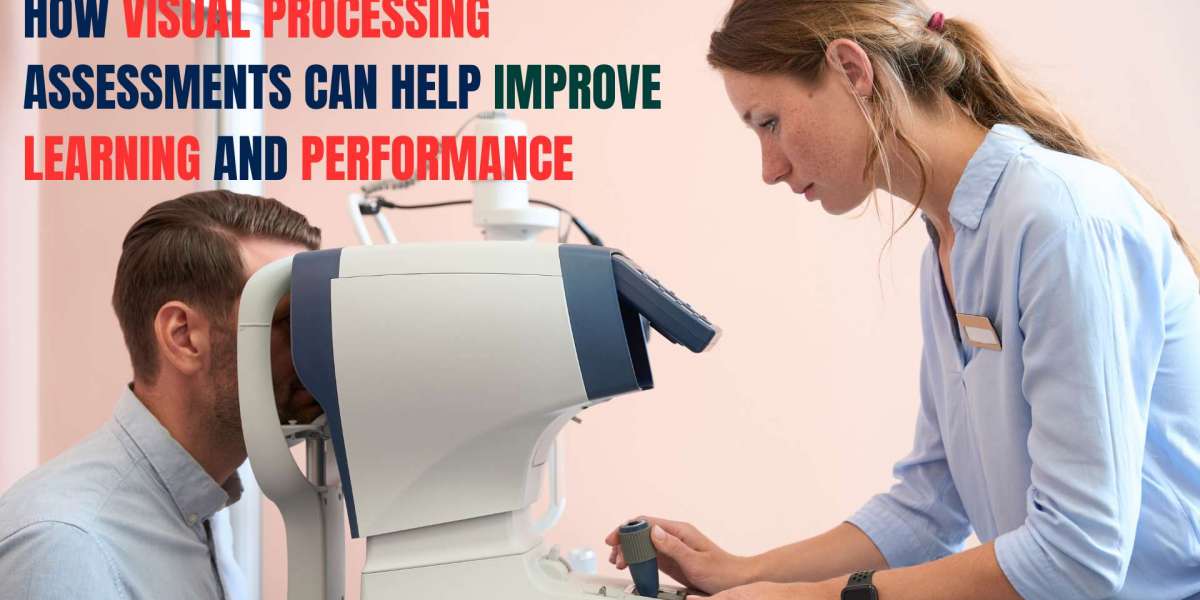Visual processing plays a crucial role in how we interpret and respond to the world around us. It involves the brain's ability to process, interpret, and make sense of visual stimuli, such as shapes, colors, letters, and numbers. For children and adults alike, efficient visual processing is essential for success in learning, reading, writing, and everyday tasks. When there are difficulties in visual processing, it can lead to challenges in academic performance, attention, and even motor skills. This is where a Visual Processing Evaluation can make a significant difference.
In this guest post, we'll explore what a Visual Processing Evaluation is, why it matters, and how it can be used to improve learning and performance across various areas of life.
What is a Visual Processing Evaluation?
A Visual Processing Evaluation is a comprehensive assessment designed to measure how well the brain processes visual information. Unlike a standard vision test, which assesses how clearly a person can see objects at different distances, a visual processing evaluation delves deeper into how the brain interprets and responds to what the eyes see.
Visual processing involves several different components, including:
- Visual Discrimination: The ability to see differences and similarities between objects or symbols.
- Visual Memory: The ability to remember visual details over time.
- Visual-Spatial Skills: The ability to understand and organize objects in space, including concepts like depth and distance.
- Visual Motor Integration: The ability to coordinate vision with body movements, such as hand-eye coordination.
- Visual Closure: The ability to recognize an object or word even when parts of it are missing.
- Figure-Ground Perception: The ability to distinguish an object from its background.
By evaluating these different aspects of visual processing, specialists can gain a deeper understanding of how an individual interprets and reacts to visual stimuli. This evaluation is especially helpful for identifying processing weaknesses that may be contributing to learning difficulties.
Why is a Visual Processing Evaluation Important?
Visual processing difficulties often go unnoticed because they do not always manifest in obvious ways, like blurry vision or trouble reading text from a distance. Children with visual processing issues might be able to see clearly but still struggle with reading comprehension, handwriting, or paying attention in class. These challenges can have a ripple effect on academic performance, behavior, and self-confidence.
A Visual Processing Evaluation helps pinpoint specific areas where a child or adult might be struggling. For example, if a child has difficulty with visual memory, they may find it challenging to remember words they've just read, which can affect reading comprehension and retention. If someone has trouble with visual-spatial skills, they may struggle with tasks like reading maps, organizing information, or participating in sports.
Once these issues are identified, targeted interventions and therapies can be implemented to address and improve these skills, leading to better performance both in school and in daily activities.
Key Signs of Visual Processing Difficulties
Identifying when someone might benefit from a visual processing evaluation is crucial, particularly when difficulties aren’t due to vision problems. Here are some common signs that may indicate a need for this assessment:
- Reading difficulties: Problems with tracking lines of text, skipping words, or losing one's place while reading are often signs of visual processing difficulties.
- Writing challenges: Poor handwriting, uneven spacing between letters or words, or difficulty copying from the board may signal issues with visual-motor integration.
- Difficulty with organization: Trouble organizing thoughts on paper, difficulty following directions, or problems with understanding visual schedules can point to issues with visual-spatial skills.
- Trouble remembering what was seen: A child or adult may have difficulty recalling visual information, such as where an item was placed, remembering how words are spelled, or recognizing patterns.
- Struggling with puzzles or visual games: Inability to complete age-appropriate puzzles, difficulty with building blocks, or problems understanding patterns can also be indicative of visual processing issues.
- Attention and focus challenges: If someone appears distracted or disorganized, particularly when working with visual tasks, this could be a sign of underlying visual processing difficulties.
These signs don't always mean there is an issue, but they can indicate the need for further assessment. A Visual Processing Evaluation can help uncover the root cause of these difficulties and provide a pathway for improvement.
How Visual Processing Evaluation Improves Learning and Performance
Identifying visual processing challenges through a Visual Processing Evaluation can significantly improve learning and performance, especially for children struggling in academic environments. Here’s how:
1. Targeted Interventions
Once a visual processing issue is identified, educators, parents, and therapists can develop specific strategies to address the weaknesses. For example, if a child struggles with visual memory, activities designed to improve memory retention through repetition and visual cues can be introduced. Similarly, a child with difficulty in visual discrimination might benefit from exercises that focus on recognizing subtle differences between letters, shapes, or objects.
2. Improved Reading and Writing Skills
For many students, visual processing difficulties are directly related to reading and writing challenges. A Visual Processing Evaluation can identify the specific areas of weakness, such as difficulty with tracking words while reading or trouble with hand-eye coordination while writing. With targeted interventions, children can improve their reading fluency, comprehension, and writing abilities, leading to better academic performance.
3. Enhanced Focus and Attention
Some students appear easily distracted or disorganized, but these behaviors may stem from underlying visual processing issues. For example, a child who has trouble with figure-ground perception might struggle to focus in a classroom where there’s a lot of visual noise. Once this issue is identified, strategies can be implemented to help them filter out distractions and focus better, resulting in improved attention and engagement in class.
4. Better Hand-Eye Coordination and Motor Skills
Children with visual-motor integration issues may have trouble with activities that require hand-eye coordination, such as writing, playing sports, or even tying their shoes. A Visual Processing Evaluation can help identify these challenges, allowing for exercises and activities that strengthen hand-eye coordination, improve fine motor skills, and increase confidence in physical activities.
5. Boosted Confidence and Self-Esteem
Children and adults who struggle with visual processing issues often feel frustrated or discouraged, especially when they don’t understand why they’re having trouble with tasks that seem easy for others. Identifying the root cause of these difficulties through a Visual Processing Evaluation can be empowering. With the right support, individuals can overcome their challenges, leading to increased confidence, improved performance, and a more positive outlook on learning and life.
Who Should Get a Visual Processing Evaluation?
A Visual Processing Evaluation can be beneficial for a wide range of individuals, including:
Children: Children who struggle with reading, writing, math, attention, or coordination may benefit from an evaluation, especially if they’ve been diagnosed with learning disabilities like dyslexia or ADHD.
Adults: Adults who experience challenges with visual tasks at work or home, or who have difficulty with activities requiring hand-eye coordination, may also benefit from a visual processing evaluation.
Athletes: Visual processing is crucial in sports, and athletes who struggle with tracking fast-moving objects, judging distances, or reacting quickly might find a visual processing evaluation helpful for improving performance.
Anyone with a Traumatic Brain Injury (TBI): Visual processing issues can arise after a head injury. For individuals recovering from TBIs, a Visual Processing Evaluation can identify areas of concern and guide rehabilitation efforts.
Conclusion
A Visual Processing Evaluation is a powerful tool for identifying underlying visual processing issues that may be hindering learning and performance. By assessing various aspects of visual processing, such as visual memory, discrimination, and spatial skills, professionals can pinpoint specific areas of difficulty and develop targeted interventions to address them. This leads to improved academic performance, better motor coordination, enhanced focus, and increased confidence.
Whether for children struggling in school, adults dealing with everyday visual challenges, or athletes looking to boost performance, a visual processing evaluation offers valuable insights that can lead to meaningful improvements in various areas of life.








